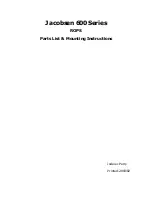
Qu Mixer Reference Guide
13
AP9372 iss.9
4.
Connection Overview
The following connections are available on the rear panel of the Qu mixer. The Qu-16 is shown here.
4.1
Local Input Connections
Mono Line Input
– Balanced ¼” TRS (Tip, Ring,
Sleeve) jack input for plugging in line level signals such as
multitrack players and radio mic receivers. To work with
unbalanced sources use a mono jack or link ring to sleeve
within the TRS stereo jack.
Use DI boxes plugged into the Mic input for high
impedance, low level sources such as acoustic instrument
pickups.
Microphone Input
– Balanced XLR input for plugging
in a low level source such as a microphone or DI box. 48V
can be switched to the socket for condenser mics and active
DI boxes that require phantom power.
To avoid loud thumps, mute the channel before plugging
in cables or equipment while 48V is turned on.
Stereo Line Input
– ST1 and ST2 balanced ¼” TRS
(Tip, Ring, Sleeve) jack inputs for plugging in line level
stereo sources such as CD players (ST2 not provided on
Qu-SB). The L input normals (switches) through the R input
so that you can work with a mono source by plugging into
just the L/M input.
To work with RCA phono connections use jack to RCA
converter plugs.
Talkback Input
– Dedicated balanced XLR input for
plugging in a microphone to route to the mixes for the
engineer to talk to the performers on stage. Phantom power
can be switched to the socket for condenser microphones.
The Talkback Input is not provided on Qu-SB.
Pin2 = hot
AES digital out
(not Qu-SB)
2-Trk and Alt out
(not Qu-SB)
LR main out
Lamp (not Qu-SB)
Talkback
Mic in (not
Qu-SB)
ST1 and ST2
stereo line in
(not Qu-SB)
Analogue Mix outputs
Mic and Line inputs
Network
dSNAKE remote audio
USB B streaming
Kensington
Lock
Cable
clamp
Power On/Off
Mains power input
Mains fuse














































